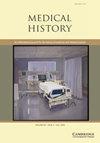Sethina Watson, On Hospitals: Welfare, Law and Christianity in Western Europe, 400–1320 (Oxford, UK: Oxford University Press, 2020). 376 pp. ISBN 978-0-19-884753-3.
IF 1.1
2区 哲学
Q4 HEALTH CARE SCIENCES & SERVICES
引用次数: 0
Abstract
struggling to assess historical materials from the PRC. In the conclusion, Fang clarifies the core concept of the ‘emergency disciplinary state’ and discusses similarities to how the PRC has responded to the COVID-19 pandemic. Fang’s core argument is that the PRC’s emergency disciplinary state was established in reaction to the El Tor cholera pandemic. However, the book can also be read as an account of the resistance, confrontations, and negotiations that occurred between various strands of power in moving towards that style of governance, whichwas not without its blind spots: public health staff encountered difficulties and even violence when attempting to check inoculation certificates of officers in the People’s Liberation Army (Chapter 4); overseas Chinese were exempted from vaccination certificate checks because the PRC needed their remittances and skills (Chapter 4); and the Zhejiang government adapted its 1963 vaccination campaign to avoid peak farming season due to the passive participation of local cadres and farmworkers the previous year (Chapter 6). There was therefore some flexibility in the PRC’s seemingly strict approach to epidemic control. It is unfortunate that Fang does not analyse the sources cited in the text more often, as the rare occasions where he weighs in on conflicting information encountered in the archives (pp. 41–3) are enlightening. Chapter 2 also includes some passages in which the causal relationship between environmental and social factors and the public health situation are not clearly established by historical sources or by the author himself (pp. 74–5, 100). Fang’s account of this much-overlooked public health crisis draws on abundant historical materials. The book is a must-read for historians and students interested in the PRC’s health policies, as well as for those curious about crisis governance in the PRC at the national, provincial, and county levels during transitional years between the Great Leap Forward and the Cultural Revolution.塞西娜·沃森,关于医院:福利,法律和基督教在西欧,400-1320(牛津,英国:牛津大学出版社,2020)。376页,ISBN 978-0-19-884753-3。
努力评估来自中国的历史材料。在结语中,方阐明了“紧急纪律状态”的核心概念,并讨论了与中国应对COVID-19大流行的相似之处。方的核心论点是,中华人民共和国的紧急纪律状态是为了应对埃尔托尔霍乱大流行而建立的。然而,这本书也可以解读为在走向这种治理方式的过程中,不同权力派别之间发生的抵制、对抗和谈判,这种治理方式并非没有盲点:公共卫生人员在试图检查人民解放军军官的接种证书时遇到困难甚至暴力(第4章);由于中华人民共和国需要侨汇和技能,海外华人免于接种证明检查(第四章);由于前一年当地干部和农场工人的被动参与,浙江政府调整了1963年的疫苗接种运动,以避免农业旺季(第6章)。因此,中国看似严格的流行病控制方法具有一定的灵活性。不幸的是,方没有更经常地分析文本中引用的来源,因为他在档案中遇到的冲突信息的罕见场合(第41-3页)是有启发的。第2章还包括一些段落,其中环境和社会因素与公共卫生状况之间的因果关系没有得到历史资料或作者本人的明确确立(第74-5页,100页)。方对这场被忽视的公共卫生危机的描述借鉴了大量的历史材料。对于那些对中国卫生政策感兴趣的历史学家和学生,以及那些对大跃进和文化大革命之间的过渡时期中国国家、省、县三级的危机治理感兴趣的人来说,这本书是必读的。
本文章由计算机程序翻译,如有差异,请以英文原文为准。
求助全文
约1分钟内获得全文
求助全文
来源期刊

Medical History
医学-科学史与科学哲学
CiteScore
1.60
自引率
0.00%
发文量
25
审稿时长
>12 weeks
期刊介绍:
Medical History is a refereed journal devoted to all aspects of the history of medicine and health, with the goal of broadening and deepening the understanding of the field, in the widest sense, by historical studies of the highest quality. It is also the journal of the European Association for the History of Medicine and Health. The membership of the Editorial Board, which includes senior members of the EAHMH, reflects the commitment to the finest international standards in refereeing of submitted papers and the reviewing of books. The journal publishes in English, but welcomes submissions from scholars for whom English is not a first language; language and copy-editing assistance will be provided wherever possible.
 求助内容:
求助内容: 应助结果提醒方式:
应助结果提醒方式:


